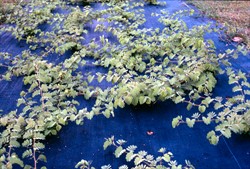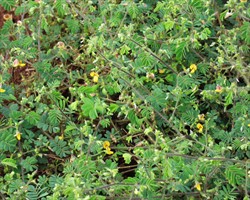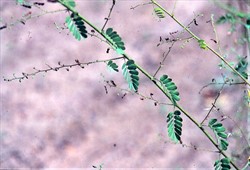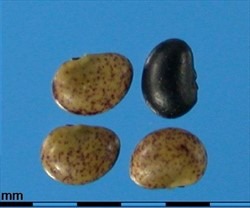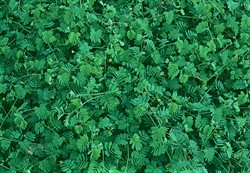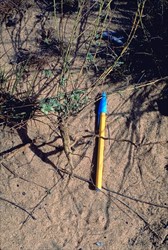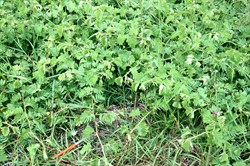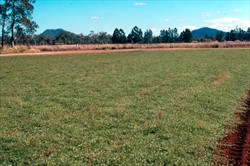Tropical Forages
Aeschynomene brasiliana (Poir.) DC.
Subordinate taxa:
Aeschynomene brasiliana (Poir.) DC. var. brasiliana
Aeschynomene brasiliana (Poir.) DC. var. venezolana Rudd (not listed in GRIN)
Note: The genus, Aeschynomene, is separated into two sections: Aeschynomene and Ochopodium. The former encompasses species predominantly from humid environments, such as Aeschynomene americana, Aeschynomene indica and Aeschynomene villosa, while the latter includes a number of dryland species, such as Aeschynomene brasiliana, Aeschynomene falcata and Aeschynomene histrix.
Family: Fabaceae (alt. Leguminosae) subfamily: Faboideae tribe: Dalbergieae.
Prostrate or decumbent herb with stems to about 2 m, glandular-hispidulous (bristly and sticky), also crisp-pubescent, woody near the crown; tap-rooted. Leaves pinnate, 2‒3 cm long, 8–20 (‒22)-foliolate; stipules ovate, acuminate, 3–4 mm long, about 1 mm wide at base, glandular-hispidulous, ciliolate; petiole and rachis with indument like the stem; leaflets obovate-elliptic to oblong, 5‒15 mm long and 3‒8 mm wide, sparsely pubescent to glabrous on the upper surface. Inflorescence comprising 1‒8 mostly yellow flowers, calyx hispidulous, standard about 6 mm long. Pod with 2‒5 segments, crisp-pubescent and also glandular-hispidulous, each article about 2.5‒3 mm long and 2‒3 mm wide. Seeds dark brown, about 2 mm long and 1‒1.5 mm wide; 200,000‒300,000 seeds/kg.
var. brasiliana: fruits 2–3 (‒4)-jointed , stipes 3–4 mm long, leaves 8–13-foliolate, leaflets predominantly obovate.
var. venezolana: fruits 4–5-jointed, stipes 4–5 mm long; leaves are 14–20-foliolate, leaflets predominantly oblong.
Description based on Rudd (1955).
English: Brazilian jointvetch
Latin America: lentilha do campo (Brazil); pega-pega (Panama)
Native:
Northern America: Mexico (Chiapas, Guerrero, Jalisco, Michoacán, Nayarit, Oaxaca, Tabasco)
Caribbean: Cuba, Trinidad and Tobago (Trinidad)
Central America: Belize, Costa Rica, El Salvador, Guatemala, Honduras, Nicaragua, Panama
South America: Brazil, Bolivia, Colombia, Ecuador, French Guiana, Guyana, Peru, Suriname, Venezuela
Forage
The only perceived value of Aeschynomene brasiliana at this stage is for legume enhancement of poor quality grassland. It has no value for cutting systems due to sticky nature of stems and fruits.
Widespread in tropical America, along roadsides, in brushland, savanna, and open pine-oak woods.
Soil requirements
Mostly collected from sandy soils of very low up to near neutral pH. Although showing best performance on friable, sandy-surfaced soils, Aeschynomene brasiliana has also persisted on well-drained soils with hard-setting surface. Appears to have adaptational range approaching that of Stylosanthes scabra and S. viscosa.
Moisture
Rainfall at collection sites ranges from 650 to 2,200 mm/yr, but mostly between about 800 and 1,000 mm/yr. Although one collection site was subject to flooding, Aeschynomene brasiliana does not appear to tolerate more than short-term waterlogging.
Temperature
Occurs from about 23º N in Mexico and Cuba to about 23º S in Paraguay, at low and high altitudes (up to about 3,000 m asl) in the tropics, but only at low altitude in less tropical areas. This places most collection sites as having an annual average temperature in the range 24‒27 ºC, and less in the extreme upland tropics. Tops are killed by frost but established plants usually recover with the onset of warm conditions.
Light
No information available.
Reproductive development
Appears to have short day flowering response; those accessions tested flowering mid to late March at 21º S.
Defoliation
Tolerates regular defoliation but generally not selectively grazed by cattle.
Fire
Established plants survive fire, and hardseededness of soil seed is reduced by fire.
Guidelines for establishment and management of sown forages.
Establishment
Mechanical scarification of hand-harvested seed may be necessary to overcome high levels of hardseededness. Aeschynomene brasiliana appears to be somewhat promiscuous, but may nodulate more effectively with Aeschynomene inoculum, CB 2312.
Fertilizer
No data, but like many other Aeschynomene, Aeschynomene brasiliana will probably respond to P applications in low P soils.
Compatibility (with other species)
Grows with less fertility-demanding, less competitive species.
Companion species
Grasses: Andropogon gayanus, Bothriochloa bladhii subsp. glabra, Heteropogon contortus, Hyparrhenia rufa, Urochloa mosambicensis.
Legumes: Chamaecrista rotundifolia, Stylosanthes capitata, S. hamata, S. scabra, S. viscosa.
Pests and diseases
Botrytis stem rot caused by Botrytis cinerea is most pronounced in seed crops, because development of the disease is favoured by flowering and the moist conditions that often prevail at flowering time. Seed yields may be markedly reduced in affected crops, although disease incidence can be minimised by growing crops under irrigation in less humid areas.
Ability to spread
Spread readily by virtue of sticky pods, and through seed being ingested by livestock.
Weed potential
Its ability to develop high soil seed reserves (up to 2,000‒3,000 seeds/m2 after 5 years, compared with 500 seeds/m2 in Stylosanthes scabra under comparable conditions), together with its relatively low palatability and fairly wide adaptation, indicates weediness potential. Accordingly, it should be tested under sufficiently controlled conditions to facilitate eradication should the need arise.
Nutritive value
One tip sample comprising 70% leaf yielded the following:
leaf: 18% CP, 0.18% P, 23.6% ADF.
stem: 9.5% CP, 0.15% P, 46.7% ADF.
Palatability/acceptability
Aeschynomene brasiliana is not well accepted by cattle, particularly in the first season. However, cattle that have grazed it during winter or the dry season, tend to eat it more readily the following growing season. Observation suggests it is not much less palatable than . It sheds its leaf in the dry season, but cattle 'lick up' the fallen leaf.
Dry matter
Yields in grazed pastures may be as low as 100 kg DM/ha. However, estimated yields of pure stands growing under ideal conditions are in excess of 5,000 kg DM/ha.
Animal production
No information available.
Single accession from Colombia had chromosome number of 2n = 20.
During the growing season, leaf and stem material becomes quite sticky due to glandular exudates. The presence of this non-water soluble exudate is an impediment to direct header harvesting of a seed crop. However, seed yields of 400‒600 kg/ha can be obtained and up to 800 kg/ha with follow-up suction harvesting.
Susceptible to 2,4-D, 2,4-DB, MCPA, bentazone, fluroxypyr and dicamba. Tolerant of imazethapyr.
- Drought hardy.
- Persistent.
- Good seed yields.
- Adapted to sandy, acid soils of low fertility.
- Fairly low palatability.
- Presence of sticky exudate.
- Leaf drop with moisture stress.
Bielig, L.M. (1997) Chromosome numbers in the forage legume genus, Aeschynomene L. Sabrao Journal of Breeding and Genetics 29:33–39.
Csurhes, S. (2010) Weed risk assessment, Brazilian jointvetch (Aeschynomene brasiliana). Biosecurity Queensland, Brisbane, Australia. bit.ly/2U8QhJI
Rudd, V.E. (1955) The American species of Aeschynomene. Contributions from the United States National Herbarium 32:1–172. hdl.handle.net/10088/27083
None released.
CPI 92519 (CIAT 8253) Evaluated in Australia. Origin thorn-shrub ('Caatinga') environment, Rio Grande do Norte, Brazil (6.5º S, 160 m asl, 650 mm/yr). Selected as an alternative to Stylosanthes scabra - similar adaptation.
CPI 93592 (IRFL 2009) Evaluated in Australia. Origin Mato Grosso do Sul, Brazil (21.25º S, 300 m asl, 1,550 mm/yr). Slightly earlier flowering and heavier seed-set than CPI 92519; also more viscid plant parts, less palatable and greater weed threat.
